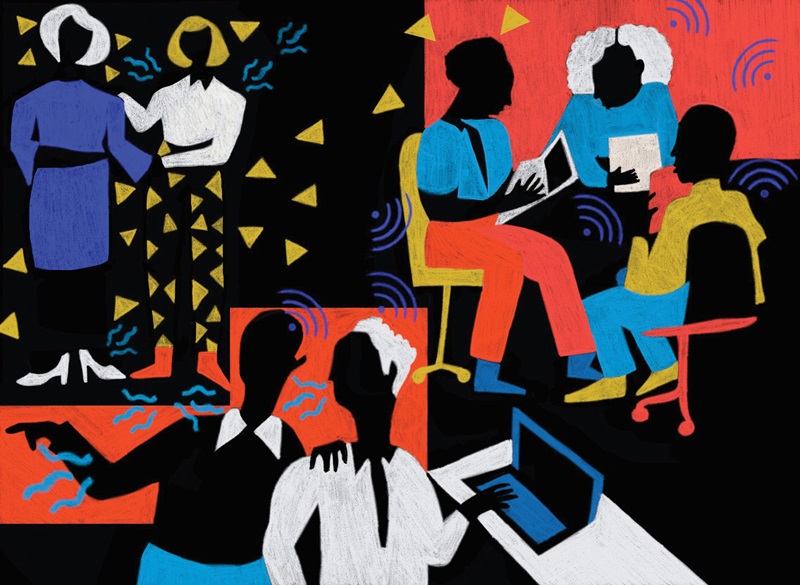
If we’ve learned nothing else from social media, it’s that networks transmit both good and evil. Social networks play a similarly ambivalent role in economics. By spreading ideas and technology, networks help transform economies from subsistence to prosperity. But social connections also spread disease, from the common cold to endemic Ebola.
STUDY AUTHORS
ALESSANDRA FOGLI is assistant director of inequality research and monetary advisor at the Minneapolis Fed. LAURA VELDKAMP is the Leon G. Cooperman professor of finance and economics at Columbia University’s Graduate School of Business.
The interactions of illness, income, innovation, and networks are multidirectional. Technology can protect and cure with better drugs and medical devices. Widespread disease lowers economic growth by impairing productivity. Networks are themselves shaped by technology and disease. They grow through new methods of transportation and communication. But to survive contagion, societies may restrict networks to curtail disease transmission—quarantine is a stark example.
Understanding how networks affect technological progress and economic growth is thus an intricate puzzle, beset by the challenges of reverse causality. But “Germs, Social Networks, and Growth,” a recent staff report (SR572) by Alessandra Fogli, assistant director of inequality research and monetary advisor at the Minneapolis Fed, and Laura Veldkamp of Columbia University provides an elegant solution—disentangling disease, development, and demographics and providing an analytical model that quantifies the effect of networks on national income, but also explains why societies embrace growth-inhibiting structures.
Their model shows that small initial differences in a nation’s epidemiological environment—disease rates or contagion capacity—can result in large and persistent differences in network structure that, in turn, generate very different levels of technological diffusion and economic output. Changing a nation’s social network can raise its productivity and growth by as much as 100 percent, according to their estimates. But if done in a high-disease environment, growth will be undercut by a parallel propagation of disease.
“In general, social networks have evolved to fit their economic and epidemiological environment,” write Fogli and Veldkamp. “Trying to change networks in one country to mimic those in a higher-income country may well be counterproductive.”
An evolutionary model
The core of their research is a model of network diffusion, a framework that enables them to measure the effect of networks on growth. Social networks have myriad dimensions; the economists focus on those that are measurable and that mediate technology diffusion, but also respond to disease. In this model, networks govern the spread of disease and technology but, inversely, disease and technology influence network evolution.
The model’s key explanatory variables, then, are disease prevalence, technology adoption, and network diffusion. National data for communicable disease prevalence are relatively easy to obtain. Measures of technology adoption are also available. A metric for social networks is more problematic. The economists develop an index from three elements: mobility, quantity of social ties in distance locations; degree, number of close personal connections; and individualism/collectivism, a society’s level of clustering. Are personal connections shared or independent? Do friends tend to have a mutual friend?
Assembling data on these variables for 71 countries and calibrating the model, Fogli and Veldkamp measure the relationship between network diffusion and national income. They find, as expected, a very high correlation. “The forces of the model can jointly explain large differences in income across countries,” they write.
A “policy experiment”
But the tight correlation of diffusion and income could be due to other factors—in particular, the impact of disease on both. To isolate the causal role of network diffusiveness, the economists try, in essence, a policy experiment: Hold the disease environment constant, vary the level of network diffusion, and see what happens to economic growth. (All experiments include two feedback effects: on innovation as infection rates rise and on infection probability as technology improves.)
Their benchmark is the United States, which has very low disease prevalence (0.05 percent for communicable diseases). In this environment, they find, high-diffusion networks have a strongly positive impact on economic growth. Doubling the number of highly mobile or connected individuals raises growth rates substantially.
But in a high-disease environment (using Ghana’s 18 percent prevalence), altering the social network to facilitate faster diffusion lowers national income. Doubling the number of highly connected individuals causes output to fall by 90 percent.
“The bottom line is that the way in which networks affect economic growth depends on the disease environment,” write the economists. High-diffusion networks spread pathogens and impoverish nations in which disease is prevalent. In low-disease nations, diffuse networks have fewer pathogens to spread. Ideas go viral, not germs. “The same networks that impoverish poor countries can facilitate growth in rich ones where epidemics are rare. To thrive, each country needs a social network that is well adapted to its environment.”
Network origins
Fogli and Veldkamp’s primary query is, as they put it, “about the effect, not the origin, of networks.” But understanding how networks emerge and evolve in response to disease is key to appreciating why modifying networks can be dangerous. In a separate exercise, the economists therefore run multiperiod simulations of two identical economies that vary only in their initial rates of disease prevalence.
In low-disease environments, the simulations generate high-diffusion networks because individuals who are connected, independent, and mobile prosper. They’re exposed to more new ideas and enjoy higher income and greater rates of reproduction. “In low-disease environments, high-diffusion network characteristics thrive.”
But in high-disease environments, the opposite happens—people with more friends, greater mobility, and higher independence get sick quickly. “They may also get new ideas,” observe Fogli and Veldkamp. But if they’re sick, they are “unproductive, regardless of [their] technology. One has to be alive and well to be productive.”
So, again, when disease is common, altering networks can be a bad idea: “Changing the network without changing the disease environment can be disastrous. A high-diffusion network, in a place where disease is prevalent, is a recipe for epidemics and humanitarian crisis.”
Confirmation from a second method
The economists test findings from their model by using a second method, a technique called “instrumental variable estimation.” It employs regression analysis with variables that are related to networks, disease, technology, and growth, but don’t suffer the reverse causality inherent to their model. With data on nine communicable diseases in 160 countries, they measure the difference in prevalence of diseases transmitted by humans and those spread by animals. These illnesses have similar impact on technology diffusion, but they differ in relation to social networks, so reverse causality is not an issue.
The findings are reassuring. Results from the full set of countries show that increasing the network diffusion level strongly increases worker productivity and per capita GDP. But splitting the sample between high-disease and low-disease countries “suggests a more subtle message that echoes the results of the model,” observe Fogli and Veldkamp. As their main method indicated, network effects differ. “The positive effect of social networks only appears for the low-disease prevalence countries.” Thus, policies to implement high-diffusion social networks would be ill-advised in nations where communicable diseases are common.






